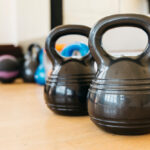Working out while pregnant? Always a win. The benefits are huge… From better mood and more energy to less back pain and a smoother recovery after birth. But let’s be honest… doing the same core moves and Pilates ball routines over and over gets old. Fast.
When the workouts start to feel like a chore, it’s time to switch things up. And no, just because you’re pregnant doesn’t mean your arms are off-limits. You can (and should) train them too.
This guide is all about arm exercises during pregnancy that keep things light, safe, and most importantly, not boring. Let’s get into it.
Can I Do Arm Exercises During Pregnancy?
Absolutely, arm exercises during pregnancy are safe. But like everything else, while you’re expecting, the approach needs to shift a bit. You’re not training to hit new PRs. You’re training to feel good, stay strong, and support your body through major changes.
That means being smart about how you train. Things like weight, intensity, and exercise selection matter more now. We’ll break all of that down in the next section.
One thing you should skip? The “no pain, no gain” mindset. Save that energy for after you’ve recovered postpartum. Right now, your goal is to stay active, enjoy movement, and listen to your body, not grind through workouts like you’re prepping for a fitness competition.
And of course, everyone’s pregnancy is different. Always check in with your healthcare provider before adding something new to your routine. Even if you’ve been physically active before. Just to be safe.
Best Arm Exercises During Pregnancy
You don’t need to crush a hardcore gym session to keep your arms strong during pregnancy. A pair of light dumbbells or resistance bands is more than enough. These exercises target your biceps and triceps. These are the muscles that help with everything from lifting grocery bags to carrying your baby later on.
Do 2-3 sets of each exercise, aiming for 8-15 reps per set depending on how you feel that day. Focus on form, not speed.
1. Bicep Curls (With Dumbbells or Bands)
The classic arm-builder. Strengthens your biceps and preps you for all the baby lifting ahead.
How to do it:
- Stand tall with feet hip-width apart.
Hold weights or a band with palms facing up. - Curl your hands toward your shoulders, then slowly lower.
Form tips:
- Keep elbows close to your body.
- Don’t swing your arms. Control every rep.
- Engage your core for balance.
2. Hammer Curls
Same idea as bicep curls, but with a different hand position to hit the muscles a little differently.
How to do it:
- Hold weights with palms facing your sides (thumbs up).
- Curl the weights up and down in that same position.
Form tips:
- Keep your shoulders relaxed.
- Don’t let your wrists bend. Keep them straight and strong.
3. Overhead Tricep Extensions (One or Two Hands)
Great for building arm endurance, especially helpful when you’re holding your baby for longer stretches later on.
How to do it:
- Hold one dumbbell with both hands, or one in each hand if you’re using lighter weights.
- Extend your arms overhead, then slowly lower the weight behind your head.
- Raise it back up with control.
Form tips:
- Keep your elbows pointing forward, not flaring out.
- Brace your core so your back doesn’t arch.
- Avoid going too heavy. Form comes first.
4. Tricep Kickbacks
This one’s simple and super effective for tightening the back of your arms.
How to do it:
- Hinge slightly at the hips, keeping your back flat.
- Bend your elbows to 90 degrees, then straighten your arms behind you.
- Pause, then return to the start.
Form tips:
- Don’t swing the weights. Make it slow and steady.
- Keep your upper arms glued to your sides.
- If your balance feels off, do this seated or use a wall for support.
5. Wall Push-Ups (Triceps Focus)
A great low-impact push movement that also hits the triceps hard when done right.
How to do it:
- Stand facing a wall, arms extended and hands just below shoulder height.
- Bend your elbows and lower your body toward the wall, then push back.
Form tips:
- Keep your elbows tucked in close.
- Engage your core and don’t let your hips sag.
- Inhale as you lower, exhale as you push.
Can You Do Arm Exercises Without Weights During Pregnancy?
Yes, you absolutely can train your arms without weights. But you’ve got to be smart about how you do it.
A lot of traditional bodyweight moves like push-ups, dips, and pull-ups aren’t pregnancy-friendly, especially as your belly grows and your balance shifts. So instead of forcing the classics, go for modifications that work with your body, not against it.
For example:
- Swap regular push-ups for wall push-ups or knee push-ups.
- Skip tricep dips and use tricep kickbacks with resistance bands or just body tension.
- Avoid anything that puts too much pressure on your core or requires awkward positioning.
No weights? No problem.
Resistance bands are a great alternative. But only if you’re using them safely. Make sure they’re anchored properly, whether you’re standing on them or using an anchor. You don’t want a band snapping loose mid-rep.
Can I Do Dumbbell Workouts for Arms While Pregnant?
Yes, dumbbells are a good option for arm workouts during pregnancy. They’re simple, effective, and easy to control. But the key is knowing when to dial it back.
Stick with light to moderate weights that let you focus on clean form without straining. If a set feels too easy, do more reps. If it feels too hard, drop the weight or take longer rests. The goal isn’t to max out, it’s to move well, stay strong, and avoid injury.
Standard Workout vs HIIT vs Circuit
When it comes to arm toning exercises during pregnancy, the type of workout matters just as much as the exercises themselves.
Here’s a quick breakdown:
- Standard Workout: Do 3–4 sets per exercise, 4–6 exercises per session. You get rest between sets and more control over intensity.
- HIIT (High-Intensity Interval Training): Go hard for 45 seconds, rest for 15, then move to the next exercise. Rinse and repeat.
- Circuit Training: Cycle through multiple exercises (like biceps and triceps) with little to no rest in between. Rest only after the full round.
Standard workouts are your best bet during pregnancy. They let you slow down, focus on form, and actually listen to your body. HIIT and circuit training ramp up the intensity fast, and that’s where problems can sneak in. Sloppy form, overexertion, dizziness…
Pregnancy isn’t the time to prove you can out-sweat your former self. It’s the time to move with purpose, stay strong, and avoid pushing too hard.
So here’s what we recommend:
Pick 2-3 biceps exercises, 2-3 triceps exercises, stick to 8-15 reps per set, and take breaks as needed. Simple, effective, safe.
What Arm Exercises to Avoid While Pregnant?
Some moves put too much strain on your core, mess with your balance, or just carry more risk than they’re worth. Here’s what to skip:
- Heavy Overhead Presses: Anything that forces you to brace your core hard and lift heavy above your head isn’t ideal. Your posture and core stability change during pregnancy, so it’s best to avoid exercises like these.
- Dips on a Bench or Chair: Tricep dips might seem harmless, but they can put a lot of pressure on your shoulders and wrists, especially with the extra pregnancy weight.
- Pull-Ups or Chin-Ups: Too intense and too easy to overdo. These moves require major core and grip strength, which can be harder to manage safely during pregnancy.
- Push-Ups on the Floor (Later in Pregnancy): Once your belly grows, regular push-ups can strain your lower back and make breathing harder. Stick to incline or wall push-ups instead.
- Anything That Compromises Balance: If it feels wobbly or unstable, skip it. Falls are the last thing you need.
Final Thoughts
You don’t have to settle for boring workouts just because you’re pregnant. Arm exercises are totally fair game, as long as you’re smart about it. Light weights, good form, and the right type of workout go a long way in keeping you strong and steady through all three trimesters.
Stick with safe, simple movements. Skip the risky stuff. And most importantly, listen to your body. The goal isn’t to crush every workout. It’s to stay active, feel capable, and prepare your body for what’s next.





